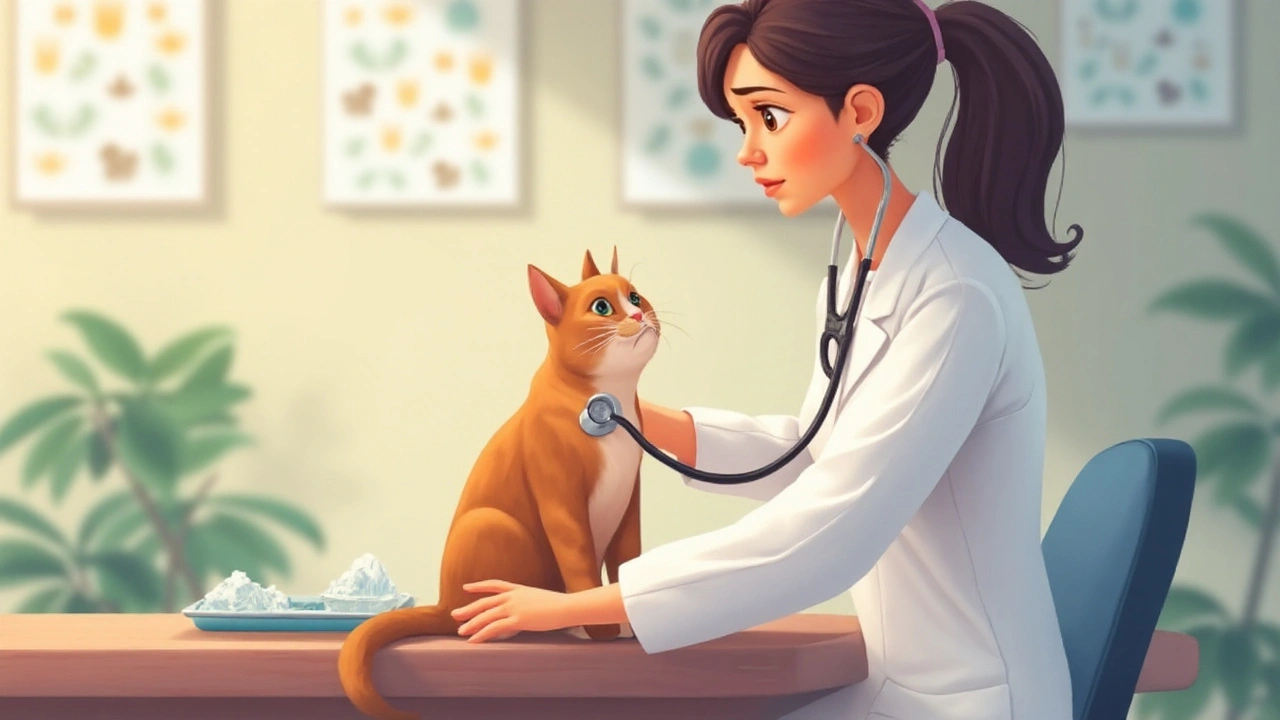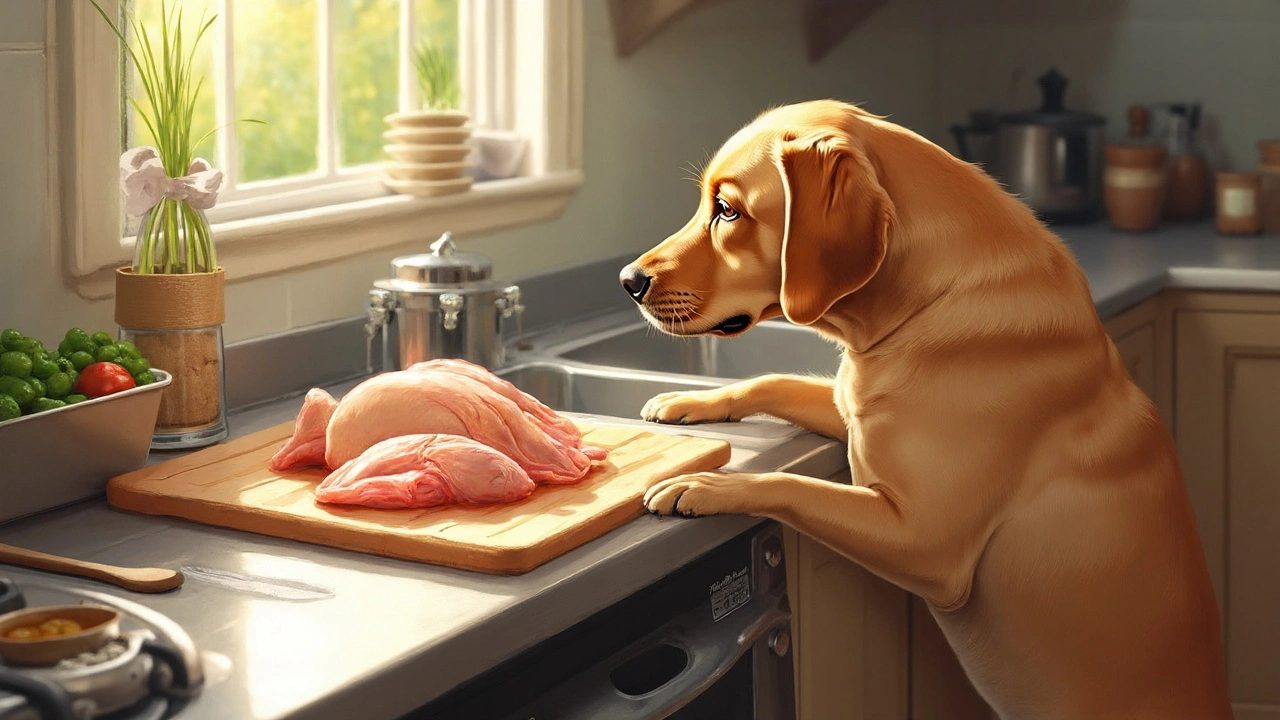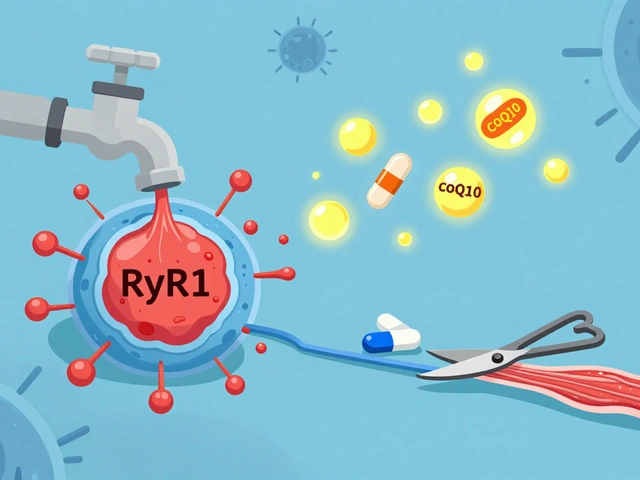Salmonella is a gram‑negative bacterium that can cause foodborne illness in humans and animals, known for its ability to survive in a wide range of environments, including pet food and water.
When you hear the word salmonella, you probably picture a botched chicken dinner or a contaminated egg. Few realize that the same microbe can quietly invade your dog’s bowl, your cat’s treats, or even a pet turtle’s tank. This article walks you through everything you need to know so you can spot infection early, treat it safely, and, most importantly, prevent it from reaching your beloved companions.
How Salmonella Gets Into Pets
Salmonella spreads primarily through the fecal‑oral route. An infected animal sheds the bacteria in its stool, and another animal (or a human) ingests it when food, water, or surfaces become contaminated. Raw meat, unpasteurized dairy, and even certain commercial pet foods can harbor the pathogen if they’re not handled correctly. The bacterium thrives at temperatures between 5°C and 45°C, making it especially stubborn in room‑temperature leftovers.
Which Pets Are Most at Risk
Dogs are domestic carnivores commonly kept as companions and can contract salmonella through contaminated food, water, or contact with infected feces.
Cats are obligate carnivores with a sensitive digestive system that may develop severe illness if they eat raw prey or tainted commercial food.
Reptiles are cold‑blooded animals often fed raw insects or rodents, making them frequent carriers of salmonella without showing signs themselves.
While dogs and cats are the most common household pets, small mammals (like guinea pigs) and birds can also be affected, especially if fed raw diets or exposed to contaminated environments.
Spotting the Signs
Salmonella infection in pets is called salmonellosis. Symptoms vary by species and age, but typical clues include:
- Loose or watery stools, sometimes with blood.
- Vomiting, especially after meals.
- Lethargy or loss of appetite.
- Fever (detected by a vet’s thermometer).
- Dehydration-skin loses elasticity, gums become dry.
In reptiles, you might notice a lack of shedding, weight loss, or a change in activity level. Because symptoms can mimic other gastrointestinal issues, a proper diagnosis is essential.
Diagnosis and Treatment
Veterinary diagnostics include fecal culture, PCR testing, and sometimes blood work to confirm salmonella presence.
When a vet confirms salmonellosis, the typical treatment protocol involves:
- Supportive care: fluid therapy to combat dehydration.
- Antibiotic therapy: Antibiotic treatment is tailored based on susceptibility testing to avoid resistance.
- Isolation: keeping the sick animal away from other pets and human family members until cleared.
Not every case requires antibiotics; mild infections often resolve with supportive care alone. However, any pet showing severe signs-especially a puppy, kitten, or immunocompromised animal-should see a vet promptly.
Preventive Measures Every Pet Owner Should Follow
Prevention hinges on three pillars: hygiene, food safety, and responsible feeding practices.
1. Hygiene at Home
- Wash hands thoroughly after handling pet food, treats, or cleaning litter boxes.
- Disinfect food bowls and water dishes daily with a diluted bleach solution (1tbsp per litre of water) or a pet‑safe sanitizer.
- Clean up pet waste promptly, especially in yards where children play.
2. Food Handling
- Store raw meat in the freezer until ready to use; thaw in the refrigerator, never on the counter.
- Cook all meat to an internal temperature of at least 74°C (165°F) to kill salmonella.
- Avoid feeding pets from plates that have contained raw or undercooked food for humans.
3. Raw Diet Considerations
Raw diet consists of uncooked meat, bones, and organs fed to pets. While many owners swear by its benefits, the raw approach carries a higher salmonella risk. If you choose a raw regimen, follow these safeguards:
- Purchase meat from reputable suppliers that test for pathogens.
- Freeze portions for at least 72hours before serving to reduce bacterial load.
- Never leave raw food out for more than two hours; discard leftovers.
- Use separate cutting boards, knives, and storage containers from those used for human food.
For households with infants, elderly, or immunocompromised members, a cooked or commercially processed diet is the safest route.

Feeding Options and Salmonella Risk - Quick Comparison
| Feeding Type | Typical Salmonella Risk | Preparation Effort | Cost (per month) |
|---|---|---|---|
| Commercial kibble (high‑grade) | Low - heat‑treated during manufacture | Minimal - just pour & serve | £30‑£45 |
| Cooked homemade meals | Moderate - depends on cooking thoroughness | High - cooking & portioning required | £50‑£70 |
| Raw diet (meat & bones) | High - raw meat can harbor salmonella | High - safe handling protocols essential | £70‑£100 |
| Fresh wet food (canned) | Low‑moderate - sealed and pasteurized but can be contaminated after opening | Low - store properly after opening | £40‑£60 |
Beyond Your Pet: Zoonotic Implications
Salmonella is a classic zoonosis-a disease that jumps from animals to humans. In households where a pet is infected, family members can contract the bacteria by:
- Touching contaminated fur or paws and then their mouth.
- Sharing food bowls or kitchen surfaces.
- Cleaning litter boxes or cages without gloves.
People most vulnerable to severe salmonella infection include infants, the elderly, pregnant women, and anyone with a weakened immune system. If you fall into one of these groups, strict hygiene and a cautious feeding strategy become even more critical.
Quick Safety Checklist
- Wash hands for at least 20 seconds after handling pet food or waste.
- Sanitize bowls daily; replace worn-out dishes.
- Cook all meat to ≥74°C before serving.
- If feeding raw, freeze for 72hours and keep separate from human foods.
- Store pet food in airtight containers; discard any that smell off.
- Visit the vet if your pet shows diarrhea, vomiting, or fever lasting more than 24hours.
Following these steps dramatically lowers the odds of salmonella slipping into your home.
Related Topics You Might Explore Next
Now that you understand salmonella in pets, you may want to read about:
- Food safety for pet owners: best practices for storing and preparing pet foods.
- Antibiotic resistance in companion animals.
- How to recognize other zoonotic diseases like Campylobacter and Toxoplasma.
- Designing a pet‑friendly kitchen that prevents cross‑contamination.
Frequently Asked Questions
Can my dog get salmonella from a cat?
Yes. If a cat is shedding salmonella in its feces and the dog sniffs, licks, or eats contaminated material, transmission can occur. Keeping litter boxes away from dogs and cleaning both pet areas regularly helps prevent cross‑species spread.
Is salmonella in raw pet food a myth?
No. Several independent studies have found raw pet foods to contain salmonella at rates up to 30%. The risk isn’t zero for cooked or canned foods, but raw diets consistently show higher contamination levels.
How long does salmonella survive on pet bowls?
Under room temperature, salmonella can persist for weeks on moist surfaces. That’s why daily cleaning with a bleach‑based sanitizer is recommended, especially after a pet has been ill.
Should I get my pet tested for salmonella if they seem healthy?
Routine testing isn’t necessary for asymptomatic pets. However, if you’re feeding a raw diet, have a high‑risk household, or have had a recent outbreak, a veterinarian may recommend a fecal culture as a precaution.
Can humans get salmonella from washing their hands after cleaning a pet’s bowl?
If hand‑washing is thorough-using soap and at least 20seconds of scrubbing-the risk is negligible. The danger rises when hands are rinsed quickly or when gloves are removed and not washed.
What antibiotics are effective against pet salmonellosis?
Commonly used drugs include ampicillin, enrofloxacin, and trimethoprim‑sulfamethoxazole, but susceptibility testing is essential because resistance patterns vary by region.
Is it safe to let my dog drink from a pond?
Ponds can harbor salmonella, especially after wildlife visits. If you let your dog drink, rinse their mouth and paws afterward, and monitor for gastrointestinal upset.



 Medications
Medications





Jasmine Hwang
September 23, 2025 AT 22:51so like... raw food is bad? but my dog eats kibble and still pukes once a week so idk what’s the point?? 🤷♀️
Maeve Marley
September 24, 2025 AT 09:56Look, I get the fear-mongering about salmonella, but let’s be real - dogs have been eating raw meat since before they were domesticated. Our ancestors didn’t sanitize every bowl, and yet we’re still here. The real issue isn’t salmonella - it’s the panic culture around pet food. Yes, raw diets carry risk, but so does feeding your cat kibble full of fillers and preservatives. The key is balance, not fear. Wash your hands, store food properly, and stop treating your pet like a lab rat. If your pet’s healthy and energetic, maybe don’t fix what ain’t broke. Also, bleach in water bowls? That’s overkill. A quick rinse with hot water and dish soap does just fine.
James Gonzales-Meisler
September 24, 2025 AT 17:31‘72hours’ should be ‘72 hours’ - missing space. Also, ‘1tbsp per litre’ lacks a space before the unit. These aren’t minor errors; they undermine the credibility of an otherwise well-researched piece. Precision matters, especially in medical advice.
Navin Kumar Ramalingam
September 25, 2025 AT 18:54raw diet = elite pet parenting. kibble = basic. if you’re feeding your dog kibble, you’re not really a pet parent - you’re just a landlord with fur. also, your turtle probably judges you.
Shawn Baumgartner
September 26, 2025 AT 20:20Let’s cut through the fluff: this article is a corporate shill for Big Pet Food. Kibble is sterilized because it’s made from 4D meat - dead, diseased, dying, and dumped. The FDA has documented salmonella outbreaks in commercial kibble too. The real threat isn’t raw meat - it’s the lack of transparency in the pet food industry. They’re selling you poison in a bag labeled ‘premium.’ You think your vet’s recommending kibble because it’s healthy? No - they’re paid by the manufacturers. Wake up. Your pet’s immune system is being slowly murdered by fillers and chemical preservatives. This isn’t prevention - it’s propaganda.
Cassaundra Pettigrew
September 26, 2025 AT 23:51Okay but like, why are we even letting these animals live in our homes if they’re just gonna poison us? I mean, I get it - pets are cute, but salmonella? In my house? No. My kid’s 3. My grandma’s on chemo. If you’re feeding raw, you’re not a pet owner - you’re a public health hazard. Get a goldfish. At least it doesn’t try to kill you with its poop.
Brian O
September 27, 2025 AT 13:49I’ve been feeding my rescue dog a raw diet for 4 years now. He’s got the coat of a show dog, zero digestive issues, and zero salmonella. But I also wash my hands like I’m in an operating room, freeze everything for 72 hours, and use separate cutting boards. It’s not about avoiding risk - it’s about managing it responsibly. To everyone panicking: if you’re scared, go with canned or kibble. No shame. But don’t shame the people who do it right. We’re not reckless - we’re informed.
Steve Harvey
September 27, 2025 AT 16:17Did you know the CDC is hiding data on pet food contamination? I’ve got friends who work in USDA and they say 80% of commercial pet food has trace salmonella - they just don’t test for it because it’s ‘too expensive.’ Also, your cat’s litter box? It’s a biohazard. Your dog licks his paws after going outside? He’s ingesting rat poop. The government doesn’t want you to know this. I’ve got a drone that scans pet food bags for radiation. You think your kibble is safe? Think again. 🕵️♂️
Gary Katzen
September 29, 2025 AT 06:11I appreciate the info. I feed my senior cat wet food now because she’s got kidney issues, and I just clean her bowl after every meal. It’s not perfect, but it’s what I can do. Thanks for the checklist - I’ll start using the bleach solution. Small steps, right?
ryan smart
September 30, 2025 AT 13:58raw food bad. kibble good. america first. wash your hands. end of story.
Sanjoy Chanda
September 30, 2025 AT 15:06My neighbor’s turtle gave her grandson salmonella last year. Kid was in the hospital for 3 days. I used to feed my parrot raw nuts - now I roast them. It’s not about fear. It’s about love. You don’t have to go full raw or full kibble. Just be aware. Small changes matter. Your pet doesn’t need a gourmet diet - they need you to be careful.
Sufiyan Ansari
October 1, 2025 AT 08:01It is an epistemological imperative to recognize that the domestication of animals has introduced a profound ethical and biological paradox: we anthropomorphize our companions while simultaneously exposing them to anthropogenic hazards. The salmonella paradigm, therefore, is not merely a microbiological concern but a reflection of our societal dissonance - wherein the commodification of pet nutrition collides with the moral obligation to preserve life. One must, with solemnity, reconsider the ontological status of the pet in the modern household.
megha rathore
October 1, 2025 AT 23:51OMG I just realized my dog licked my face after eating raw chicken 😭 I’m gonna die before 30 😭 my skin is breaking out already 🤢 #salmonellalife #petsarekillingme
prem sonkar
October 2, 2025 AT 05:33wait so if i freeze raw meat for 72hrs, does that kill all the bad stuff? or just make it less bad? my dog eats raw but i dont know if im doin it right 😅